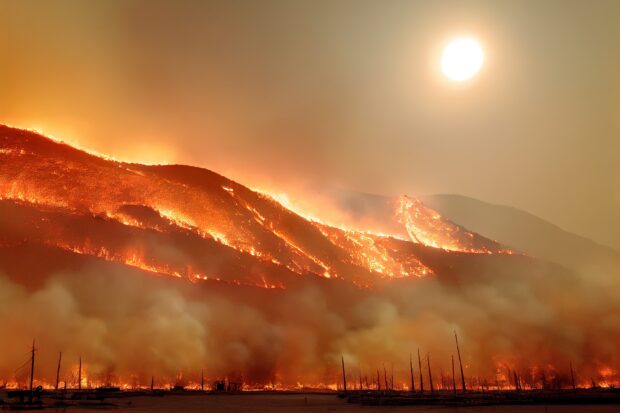While two dozen interested parties spoke at a recent California Department of Insurance workshop on the use of catastrophe modeling in pricing, offering predictable messages supporting carrier, vendor and consumer interests, two speakers stood out from the pack.
Related article: California’s Next Steps: Picking the Right Cat Models and Staffing Up
One was the chief executive of an insurance carrier whose company that uses no cat models at all. The other was the CEO of a nonprofit in Alabama.
“We have a small book of business in California, but even so it represents over $60 billion of potential losses if we were to have just an incredibly catastrophic event,” said Marcus Linden, president and CEO of CSE Insurance. “We clearly don’t have that kind of money sitting on our balance sheet or in our bank account,” he said, noting that CSE needs to purchase reinsurance to protect itself from such an extreme tail event.
Explaining the process of talking to 20 or 30 reinsurers around the world, and picking the best quotes possible, he said, “We don’t have a choice to not buy reinsurance if we want to do business in the state, given the risk that exists for our book of business.”
“We don’t even run [catastrophe] models ourselves. Those reinsurers, they’re running various models and establishing the price that they offer us, which then becomes a cost,” he said, adding that any inability to pass that reinsurance along is the underlying problem that makes it unsustainable for regional carriers like CSE to conduct business in the state.
“I appreciate very much the conversation around the use of models, but for us—and I don’t think we’re unique—we’re not on the front lines of actually using the models. We’re recipients of the models that the reinsurers use and we always will be. Our choice is either to pay the price that they charge us or to walk away from being able to offer insurance if we’re not able to recapture that cost,” Linden said.
The CDI workshop was focused on questions about the impact of using catastrophe models on affordability and availability for consumers, the ability of cat models to capture the impacts of wildfire mitigation efforts, potential model review procedures to use during the rate department’s approval process and issues of model transparency, accuracy and variability. (Related article: California’s Next Steps: Picking the Right Cat Models and Staffing Up)
Offering an informational perspective on how a small carrier operates within the state, Linden said CSE is, in fact, “dependent on these cat models. But we don’t run them ourselves. We’re downstream of that and must live with the outputs of that and try to navigate the marketplace as such.”
Offering an out-of-state perspective, Julie Shiyou-Woodard, president and CEO of the national nonprofit Smart Home America, recalled the post-Katrina market in Alabama, describing it as very similar to California today. “Our market bottomed and our insurance carriers left, and nonrenewals were at a critical and crisis level. And I was asked to share with you basically that it can be reversed.”
“We did do that,” Shiyou-Woodward said. “Our market now, in our highest risk areas of the state, do have affordable rates for homeowners and business owners. We are protected in this current market where rates are rising exponentially on either side of us and around us in the Gulf of Mexico, but our market is holding and we are not seeing catastrophic rises in policy costs,” she said, noting that groups like hers worked closely with Alabama regulators and the industry to fix the state’s prior problems.
“We, however, have had the ability for our industry to use cat modeling,” she said, revealing that until the day of the workshop she was unaware that cat models haven’t been use by carriers in California to determine adjustments for pricing. “I’m not sure how they’ve actually been able to put accurate rates in place,” she said quizzically .
“It is a very significant, important tool for a carrier to understand the risks that they are walking into and writing, and to fairly price those.”
Shiyou-Woodward said that Alabama communities worked with the insurance industry to identify ways to mitigate risk in order to bring down “astronomical rates,” with the cat models helping to quantify the potential impacts of those risk-reduction efforts.
“I encourage there to be an open-mindedness to this, with all of the cautionary statements that have been [voiced here]. But having that modeling tool allows those rates to be fairly set—and also stabilizes your market and reduces that volatility over time because [carriers] have a full picture of what their risk is. [And] when we, as homeowners, make those mitigation efforts and prove that we’ve mitigated, then there is an opportunity for that industry to recognize that” with rates that accurately reflect lower levels of risk.
“It’s taken us a really long time. It’s not an easy path,” she said, asserting that there are more insurance carriers writing in Alabama not than before 2004—at fair and affordable prices.
“I don’t know the answer for you as a state, but I know that it can be done,” she told California workshop attendees.
Moonshots and Forest Treatment
Also offering slightly different messages than other speakers during the workshop were a technologist and a former California insurance commissioner.
Representing X, a division of Alphabet formerly called Google X, Alex Kozak said the company that builds moonshot technologies and companies like self-driving car company, Waymo, and drone delivery company, Wing, encourages machine learning approaches to wildfire risk assessment.
“For the last few years, my colleagues have been working pretty diligently on applying machine learning and cloud computing to a wide range of geospatial data sets to make long-term—one-to-five year predictions about wildfire risk at a local level,” he said. Expressing the desire to help “wildfire stakeholders [to] better deploy public dollars based on ground-truth conditions,” as well as the ability to simulate the impact of mitigation efforts, Kozak said, “We actually think we’ve cracked some of the hard technical challenges of this problem. We’re able to make really long-term predictions that are pretty high quality for areas or structures based on hundreds of factors—I believe it’s over 600 at this point,” encompassing environmental factors, natural conditions and human conditions “on the ground and in the built environment.”
Said Kozak, “The purpose of these comments really just to encourage CDI to incorporate computationally heavy approaches to doing modeling into their analysis and planning longer term—and specifically machine learning models.”
“We think there’s a ton of benefit to the state and the public if we can jump ahead of intermediate approaches to a more technologically advanced way of doing wildfire modeling.”
While representatives of well-known probabilistic catastrophe modeling firms also described the abilities of their models to simulate mitigation efforts like home hardening and creating defensible space, Dave Jones, who served as CDI commissioner from 2011-2018, and Sarah Heard, who heads The Nature Conservancy (TNC), said that underwriting models used by insurers today do not take forest treatment efforts into account.
Heard reported that while climate change is partly responsible for a growing wildfire crisis, more than a century of “logging and fire suppression has led to overstocked forests with many more small trees than historically existed,” which are particularly vulnerable to bigger and hotter wildfires, as compared to more open forests with fewer larger trees.
TNC advocates for ecological forestry or forest treatment, which means using thinning, burning, restore forest to healthier conditions, she said, going to show side-by-side photos illustrating the impacts of ecological forest management—on one side, an untreated forest with wildfire flame lengths over 50 feet, reduced to four feet in a treated landscape on the other.
TNC partnered with Willis Towers Watson in 2021 to quantify loss and premium savings for an ecological forest restoration project in the watershed of Placer County Water Agency, she said, noting that the WTW models revealed that modeled insurer average annual losses fell in the range of 40-60 percent, producing a similar reduction in premiums for property owners. “For the 81,000 homes in the watershed, we found aggregate premium savings of $21 million per year,” Heard said.
“The good news is that the state of California is making substantial investments in forest treatment,” reported Jones, who is now director of the Climate Risk Initiative at UC Berkeley’s Center for Law, Energy and the Environment. He said that California’s legislature and governor have appropriated $2.7 billion towards this goal, and the U.S. government another $5 billion nationwide.
“The problem is that the underwriting models, and in particular the risk score models that insurers are using to underwrite—to make the decision whether to write new or renew insurance, do not take into account the risk reduction benefits of landscape-scale forest management.” Rates don’t account for them either, he said.
Modeling firms speaking at the workshop say they are “able technically to account for fuel reduction,” Jones noted. He believes this would provide “a path to help insurers keep writing insurance in those areas where they’re currently finding it a challenge to write.”





















 Slideshow: Carrier Management’s 2025 Top Editor’s Picks (Unlocked)
Slideshow: Carrier Management’s 2025 Top Editor’s Picks (Unlocked)  Nearly Half of 100 Largest P/C Insurers Destroy Value: ACORD
Nearly Half of 100 Largest P/C Insurers Destroy Value: ACORD  Northern California Flooding This Weekend Caused by Heavy Rain, High Tides
Northern California Flooding This Weekend Caused by Heavy Rain, High Tides  Breaking: Andersen to Replace Zaffino as CEO of AIG on June 1
Breaking: Andersen to Replace Zaffino as CEO of AIG on June 1 





